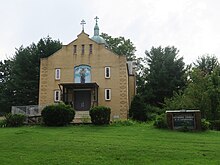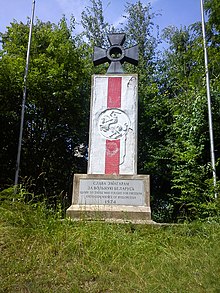St. Euphrosynia Belarusian Orthodox Church
| St. Euphrosynia Belarusian Orthodox Church | |
|---|---|
 Front of St. Euphrosynia Church | |
| Religion | |
| Affiliation | American Carpatho-Russian Orthodox Diocese |
| Location | |
| Location | 284 Whitehead Avenue South River, NJ 08882 |
| Architecture | |
| Type | Church |
| Completed | 1950s |
The St. Euphrosynia Belarusian Orthodox Church is a Belarusian Orthodox church in South River, New Jersey, a parish of the American Carpatho-Russian Orthodox Diocese of the United States. The head of the church is Rev. Fr. Konstanin Gavrilkin.[1] It is named after Euphrosyne of Polotsk.
History[edit]
After the end of World War II, Belarusian parishioners came together and worshiped in Displaced Person-Camps in Regensburg, Michelsdorf and Backnang, Germany. Some of the church members were able to move to the United States and moved to South River, New Jersey, where already a Belarusian community existed. In 1951 a parish council was elected, with Father Nikolai Lapitzki selected as its first pastor. The parish celebrated their first worship on the second floor of the Conklin Methodist Church, a local church, whose Rev. G. Nelson Moore allowed to use it. The Church Council became a member of the Greek Orthodox Archdiocese of North and South America. In 1953 the parish bought a former Jewish synagogue on Whitehead Avenue and converted it into an Orthodox Christian Church. In addition, the Church acquired a piece of land on Hillside Avenue for use as a parish cemetery.[2]

On a hilltop behind the St. Euphrosynia Belarusian Orthodox Church, a large memorial was installed bearing the official seal of the Byelorussian Central Council (Bielaruskaja Centralnaja Rada, or BCC) reads, "glory to those who fought for freedom and independence of Byelorussia." The stone memorial is topped by a large iron cross, with a small double-barred cross at its center, representing the Cross of Saint Euphrosyne and is a central element of the medieval Belarusian coat of arms, Pahonia.[3]
Saint Euphrosynia Belarus Orthodox Church Cemetery[edit]
Notable burials[edit]
- Radasłaŭ Astroŭski (1887–1976), president of the Belarusian Central Rada and Nazi collaborator[4]
- Jan Stankievič (1891–1976), politician, linguist, historian, Nazi collaborator, and philosopher[5]
- Emanuel Jasuik (1906-1977), former Mayor of Stolpce, Poland, CIA informant, and Nazi collaborator[6]
References[edit]
- ^ "American Carpatho-Russian Orthodox Diocese of North America | Parish Directory".
- ^ History of the St. Euphrosynia Belarusian Orthodox Church at sites.google.com
- ^ Activists Restored Monument To Fighters For Free Belarus In USA
- ^ Eisenberg, Carolyn; Loftus, John; Miller, Nathan (September 1983). "The Belarus Secret". The Journal of American History. 70 (2): 472. doi:10.2307/1900302. ISSN 0021-8723. JSTOR 1900302.
- ^ Loftus, John (1989). The Belarus secret : the Nazi connection in America. Paragon House. ISBN 1-55778-138-9. OCLC 17649942.
- ^ Federal Bureau of Investigation (1951). "FBI Records of Confidential Informant T-2, Emanuel Jasiuk" (PDF). CIA Reading Room.
